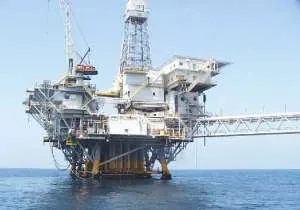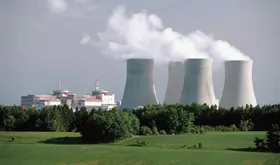
Non-renewable Energy Sources
Types of Non-renewable Energy Sources
![]() Non-renewable energy sources were formed millions of years ago, when dinosaurs walked the Earth. Today the whole world is dependent on these different types of non-renewable sources of energy, more commonly called “Fossil Fuels“, that can be found beneath our feet deep within the Earth.
Non-renewable energy sources were formed millions of years ago, when dinosaurs walked the Earth. Today the whole world is dependent on these different types of non-renewable sources of energy, more commonly called “Fossil Fuels“, that can be found beneath our feet deep within the Earth.
Fossil fuels such as coal, petroleum oil and natural gas which are all natural resources created within the Earth, are becoming more scarce daily and cannot therefore be easily replaced making them a “non-renewable” resource. So is nuclear energy.
Non-renewable energy gets its name from the fact that once these energy sources are depleted they cannot be easily replaced by natural processes at the same rate they are consumed. In other words, once these fuels have been used and burnt to provide energy, they are gone for good, they cannot be “renewed”. This means that more and more we have to look for alternate and renewable sources of energy.
But firstly we must differentiate between alternative energy sources, and renewable energy sources. Alternative energy refers to any form of energy which is an “alternative” to the more traditional fossil fuels of oil, coal and natural gas.

Renewable energy sources on the other hand are the types of alternative energies that are renewed or replenished by the natural and continuous processes of the Earth, such as sunlight from the sun or wind from the air, and so are renewable and environmentally friendly.
Humans rely heavily on fossil fuels and other non-renewable energy sources for their energy requirements. Energy comes in many shapes, sizes and forms, including chemical, mechanical, electrical, heat, and light, with most of our energy being derived originally from the sun.
Energy sources can be classified as renewable, non-renewable or inexhaustible resources. Today as a society we are strongly dependent upon non-renewable energy resources with a very high percent of all the oil that we consume being used for transportation, with the majority being used to fuel or cars.
We use energy to perform work, by converting it from one form that stores it into another we can use, such as burning coal to produce heat. Different types of energy sources have different costs with some forms of energy being more useful than others. Heat is considered low quality energy because it is easily dispersed.
Electricity is a high quality form of energy because we can transport it through wires, store it in batteries, and use it to make other forms of energy, such as rotational and mechanical energy. As a result, we typically convert non-renewable energy sources and other forms of energy into electricity.
The now know that the world’s global supply of non-renewable energy sources is limited and their use can negatively affect our environment. The main element in fossil fuels such as oil, coal and gas is carbon. The chemical reaction which takes place when we burn non-renewable fossil fuels releases a lot of harmful gas called carbon dioxide or CO2 into the atmosphere.
This carbon dioxide gas is one of the greenhouse gases which scientists believe is damaging the Ozone layer around the Earth. Over the past decades we have released so much carbon dioxide into the atmosphere that it has started to trap heat around the Earth and this in turn has created global warming which contributes to climate change.
Also, the use of nuclear power, oil, gas and coal all produce a great deal of waste products which pollute the environment. Oil, natural gas and coal produce toxic smoke which pollutes the air and affects global warming, while nuclear power is too dangerous producing radioactive wastes which can give rise to environmental disasters.
Reducing Our Dependence on Non-renewable Sources
While we have continually improved the efficiency with which we convert fossil fuels and other forms of non-renewable energy sources into useful forms of energy, we still need to reduce the amount of environmental wastes and greenhouse gases we release into our atmosphere.
To do this we must burn less fossil fuels by replacing them with a more sustainable energy sources which create little or no carbon gases and are therefore, less damaging to the environment. Other sources of energy such as wind, water, solar (energy from the sun), wave, tidal, biofuels and geothermal are now being used to satisfy the energy needs of the future.
Unlike non-renewable energy sources, renewable energy sources are those which do not diminish over time or can be replaced in a relatively short amount of time meaning that they can be used again and again and without renewable energy sources we will experience a severe lack of energy in the future.
Some renewable energy sources do emit very small amounts of carbon dioxide and other greenhouse gases, but for the most part they are less damaging to the atmosphere than burning fossil fuels so will not contribute to climate change making them less damaging to the environment.
Switching industrial facilities from burning oil and coal to burning natural gas will also reduce carbon gas emissions. Not only does natural gas burn cleaner and more efficiently, but gas fired power stations cost less to construct. Furthermore, worldwide natural gas reserves are abundant.
Renewable energy engineers argue that renewable forms of energy are cleaner than fossil fuels and less risky than nuclear power. But many scientists insist that non-renewable energy sources such as oil, coal and gas are still the way forward.
They argue that there are enough of these fossil fuel resources still in the ground to last at least another 500 years and that burning fossil fuels more cleanly – for example “capturing” carbon dioxide emissions underground – is the most feasible way of saving the environment.
The biggest problem we face today is that industrialized societies depend heavily on non-renewable energy sources and there are many reasons why the world continues to rely on them. Fossil fuels are abundantly available, easy to extract and are relatively cheap with the most commonly used types of non-renewable energy sources being: coal, oil, and natural gas, with coal being the least preferred energy source.
People use these energy resources on a daily basis and one of the primary reasons that alternative and renewable energy is so attractive is that conventional fossil fuel supplies are running out. But all energy resources, even renewable energy sources such as solar energy, are limited. The problem of finding large areas of open land to erect large solar power arrays, solar towers and/or wind turbines, or the building of new hydroelectric dams and reservoirs is politically sensitive and therefore largely avoided.
A continually growing world population consumes vast quantities of energy and power daily, with fossil fuels supplying a large percentage of the world’s energy needs through a variety of technologies. Fossil fuel coal fired power stations generate much of the world’s electricity.

Scientists are constantly looking for new ways to make fossil fuels work more efficiently and reduce pollution, but the shift away from our present consumption of non-renewable energy sources may lead to a greater reliance on nuclear energy.
Fossil fuels may be classed as non-renewable energy sources, due to their cheapness and ease of transportation, fossil fuels are widely used and widely accepted. Efficient fossil fuel transport systems are already in place with trucks, ships and large pipelines used to transport the oil, coal and natural gas to where they are needed. Allowing consumers to easily buy the fossil fuel products they use daily on practically every street corner.
So while these types of non-renewable energy sources may not be environmentally friendly, releasing greenhouse gas CO2 to the atmosphere and intensifying global warming, non-renewable energy sources in the form of fossil fuels will be used and burned for many decades to come as there are many political and financial barriers limiting the immediate growth of renewable energy technologies. But we can all do our bit for the environment by being more energy efficient and waste less energy in our daily lives.
For more information about the different types of non-renewable energy sources available, and how we use them in our daily lives, or obtain more information about the different types of fossil fuels available, or to explore the advantages and disadvantages of fossil fuels, then why not check out Amazon to order your copy from Amazon today about non-renewable sources of energy and the fossil fuels from which they derive.











does every car use oil?
Every car, motorcycle, bicycle and anything that moves.